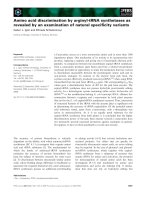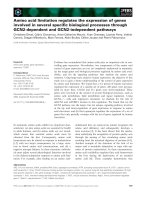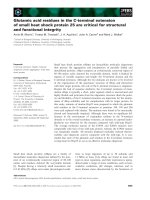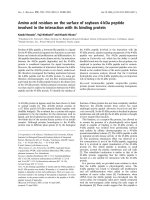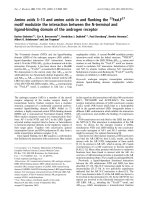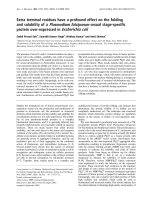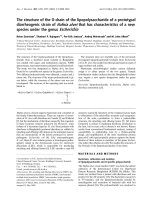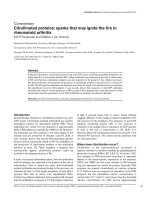Báo cáo y học: " Amino acid residues that are important for Hyal2 function as a receptor for jaagsiekte sheep retrovirus" potx
Bạn đang xem bản rút gọn của tài liệu. Xem và tải ngay bản đầy đủ của tài liệu tại đây (556.89 KB, 11 trang )
BioMed Central
Page 1 of 11
(page number not for citation purposes)
Retrovirology
Open Access
Research
Amino acid residues that are important for Hyal2 function as a
receptor for jaagsiekte sheep retrovirus
Fuh-Mei Duh
1,2
, Clarissa Dirks
3,4
, Michael I Lerman
2
and A Dusty Miller*
3
Address:
1
Basic Research Program, SAIC-Frederick, National Cancer Institute at Frederick, Frederick, Maryland 21702, USA,
2
Laboratory of
Immunobiology, Center for Cancer Research, National Cancer Institute at Frederick, Frederick, Maryland 21702, USA,
3
Fred Hutchinson Cancer
Research Center, Seattle, Washington 98109, USA and
4
Current address: University of Washington, Seattle, Washington 98195, USA
Email: Fuh-Mei Duh - ; Clarissa Dirks - ; Michael I Lerman - ; A
Dusty Miller* -
* Corresponding author
Abstract
Background: Infection by jaagsiekte sheep retrovirus (JSRV) and by enzootic nasal tumor virus
(ENTV) depends on cell-surface expression of the virus entry receptor, hyaluronidase 2 (Hyal2).
Human Hyal2 binds the envelope (Env) proteins of these viruses and is functional as a receptor, but
Hyal2 from mice does not bind Env nor does it mediate entry of either virus. Here we have
explored the amino acid determinants that account for the difference in receptor function.
Results: Analysis of human-mouse Hyal2 chimeric proteins showed that amino acid differences
responsible for the difference in Hyal2 receptor activity were localized to the central third of Hyal2.
Human Hyal2 mutants containing single or double amino acid replacements with the respective
mouse amino acids were generated across this region and were assayed for activity. None of the
single or double mutation reduced the receptor activity of human Hyal2 by more than 10-fold,
whereas mouse Hyal2 activity is reduced 1,000-fold from that of human Hyal2. While the 3-
dimensional structures of mammalian Hyal2 proteins are unknown, bee venom hyaluronidase
shows significant amino acid similarity to human and mouse Hyal2 and its structure has been
determined. Many mutations having the largest negative effects on human Hyal2 function mapped
to a small region of the bee venom hyaluronidase close to but not overlapping the active site of the
enzyme, suggesting that this site represents the binding site for Env. Analysis of synonymous and
non-synonymous nucleotide substitutions in the coding sequences of multiple mammalian Hyal2
proteins shows that the proteins are undergoing strong selection for amino acid conservation. We
found no evidence for positive selection of amino acid changes that might reflect evolution of
mammalian hosts to resist JSRV or ENTV infection.
Conclusion: These results show that the greatly reduced receptor activity of mouse Hyal2 in
comparison to that of human Hyal2 is determined by multiple amino acid changes acting in concert.
In particular, no one amino acid change blocks infection. However, the most important amino acids
map to a small patch on a predicted 3-dimensional Hyal2 structure, which may represent the
binding site for Env.
Published: 28 September 2005
Retrovirology 2005, 2:59 doi:10.1186/1742-4690-2-59
Received: 01 September 2005
Accepted: 28 September 2005
This article is available from: />© 2005 Duh et al; licensee BioMed Central Ltd.
This is an Open Access article distributed under the terms of the Creative Commons Attribution License ( />),
which permits unrestricted use, distribution, and reproduction in any medium, provided the original work is properly cited.
Retrovirology 2005, 2:59 />Page 2 of 11
(page number not for citation purposes)
Background
JSRV and ENTV are closely-related retroviruses that induce
tumors in the lower airways and nasal epithelium, respec-
tively, of sheep and goats [1]. Both viruses utilize the gly-
cosylphosphatidylinositol-anchored cell-surface protein
Hyal2 as a receptor for cell entry [2]. Hyal2 is a member
of a family of proteins, some of which exhibit high
hyaluronidase activity and are capable of rapid degrada-
tion of hyaluronan, a component of the extracellular
matrix. However, Hyal2 exhibits only weak hyaluronidase
activity [3] and its primary biological role in mammals is
not known. Evidence for Hyal2 function as the virus
receptor is provided by experiments showing that expres-
sion of sheep or human Hyal2 in cells that are not nor-
mally susceptible to infection renders the cells fully
infectable by retroviral vectors bearing the JSRV or ENTV
Env proteins [4-7]. For example, the titers of JSRV and
ENTV vectors on mouse cells expressing human Hyal2 are
>1,000-fold higher than those on cells expressing mouse
Hyal2. In addition, the receptor-binding surface (SU)
domains of the JSRV and ENTV envelope proteins bind
with high affinity to cells expressing human Hyal2 but not
to cells expressing nonfunctional receptors such as mouse
Hyal2 [6,8,9], indicating that Hyal2 is the primary recep-
tor that binds virus prior to entry.
Here we have used a transient transfection assay to ana-
lyze the amino acid differences between human and
mouse Hyal2 that account for the large difference in
receptor activity of the two proteins. Non-susceptible NIH
3T3 mouse cells were transfected with the Hyal2 expres-
sion constructs and receptor function was quantitated by
measuring transduction of the cells with a JSRV vector. We
could localize most of the difference in receptor function
to the central 38% of the Hyal2 proteins. Single and dou-
ble amino acid changes made throughout this region in
human Hyal2 to convert the residues to those in the
mouse sequence were made and tested. None of the
changes reduced human Hyal2 activity more than 10-fold,
but a combination of three of the most important muta-
tions reduced the activity by 17-fold. We conclude that the
difference in receptor activity between human and mouse
Hyal2 is explained by the effects of multiple amino acid
changes acting together. However, the most important
amino acids mapped to a small surface region of the
known bee venom hyaluronidase suggesting that this is
the binding site for Env.
Results
Deletions of the amino or carboxy termini of human Hyal2
abrogate receptor activity
The overall structure of human Hyal2 is shown in Fig. 1.
The protein is directed to the endoplasmic reticulum by a
20 amino-acid signal peptide at the amino terminus [3],
deletion of which abolishes the receptor activity of human
Hyal2 [5]. However, this signal can be replaced with a pre-
protrypsin signal sequence followed by a Flag peptide tag
without affecting the receptor activity of human Hyal2
[5]. To determine if portions of the amino terminus
beyond the signal sequence could be deleted without
affecting receptor activity of human Hyal2, we made a
series of deletion mutants that consisted of the preprot-
rypsin signal sequence followed by the Flag tag fused in
frame to the remainder of the protein. Deletion of amino
acids 1–30 of human Hyal2 (corresponding to a deletion
of 10 amino acids after the signal peptide) reduced its
activity to 1% of that of human Hyal2, and deletions of
40, 50, 60, 120, 180, 240, and 300 amino-terminal amino
acids reduced receptor activity to undetectable levels (data
not shown). Loss of receptor activity could be due to an
inability of the JSRV Env to bind the truncated receptors,
to defects in later steps of virus entry mediated by Hyal2,
or to improper folding or processing of the deletion
mutant Hyal2 proteins to the cell surface. Regardless,
these data show that most of the amino terminus of Hyal2
is required for proper receptor function, with the possible
exception that a subset of the first 10 amino acids after the
signal peptide may be dispensable for receptor function.
The carboxy end of Hyal2 is predicted to contain a GPI
addition signal, and experimental data confirms the pres-
ence of the GPI linkage of Hyal2 to the cell surface [5].
Complete removal of the GPI addition signal (amino
acids 440–473) or only the GPI addition site (amino acids
440–453) abrogated the receptor activity of human Hyal2
[5]. We have not explored whether internal deletions
upstream of the GPI signal are compatible with receptor
function or whether other membrane linkages might yield
functional receptors, but it is clear that the carboxy end of
Hyal2 is important for normal receptor function.
Analysis of chimeric mouse/human Hyal2 proteins localizes
amino acids responsible for the difference in receptor
activity to the central region of the proteins
Mouse and human Hyal2 are 82% identical at the amino
acid level but mouse Hyal2 shows 1,000-fold lower JSRV
receptor activity. In an attempt to localize the amino acids
responsible for this difference we made a series of human/
mouse Hyal2 chimeras and assayed them for receptor
function (Fig. 2). Hyal2 was divided into four domains
based on the availability of convenient restriction enzyme
sites in the cDNAs at positions corresponding to amino
acids 158, 305, and 354. Constructs are named based on
the order of the mouse and human sequences. Construct
hmmh has very low activity while construct mhhm has
activity near that of human Hyal2, showing that the cen-
tral regions of mouse and human Hyal2 are responsible
for most of their receptor phenotype. Constructs hmhh
and hhmh have activity between that of mouse and
human Hyal2 showing that both the second and third
Retrovirology 2005, 2:59 />Page 3 of 11
(page number not for citation purposes)
Human Hyal2 protein featuresFigure 1
Human Hyal2 protein features. Amino acids 1–20 constitute the endoplasmic reticulum signal peptide for human Hyal2
[3]. A glycosylphosphatidylinositol (GPI) anchor is predicted to replace all residues following amino acid 447 in human Hyal2,
which contains a C-terminal hydrophobic tail at residues 456–473 that localizes the protein in the membrane prior to GPI
anchor addition.
Receptor activity of mouse/human receptor chimerasFigure 2
Receptor activity of mouse/human receptor chimeras. Scale drawings of human (open boxes), C3H mouse (black
boxes) and chimeric Hyal2 receptors are shown. Receptor activities following transfection of NIH 3T3 mouse cells are indi-
cated at right and are expressed as a percentage of that of human Hyal2. The top diagram shows the positions of the signal
peptide (amino acids 1–20), the GPI anchor addition site (after amino acid 447), and the amino acid positions where the Hyal2
cDNAs were recombined. The human Hyal2 [GenBank:U09577.1
] and C3H mouse Hyal2 [GenBank:AF302843.1] sequences
used here have been described. The Hyal2 protein sequence of C3H mice is identical to that of NIH Swiss mice [Gen-
Bank:AF535140.1
], and differs by one amino acid (V at position 355) from that of Czech II mice [GenBank:AF302844.1] (I at
position 355).
Hyal2
GPI anchor site
(after aa 447)
Signal
peptide
1-20 456-473
100
0.1
12
4
0.4
46
0.1
72
158 305 354 44720 473
Hyal2
construct
Receptor
activity (%)
h
m
m
m
m
h
h
h
h
m
m
m
m
h
h
h
h
m
m
m
m
h
h
h
h
m
m
m
m
h
h
h
Retrovirology 2005, 2:59 />Page 4 of 11
(page number not for citation purposes)
domains of mouse Hyal2 contribute to the low activity of
mouse Hyal2. Constructs mhmm and mmhm show that
insertion of the second domain of human Hyal2 can
restore most of the activity of mouse Hyal2, while inser-
tion of the third domain of human Hyal2 is unable to
increase the low activity of mouse Hyal2. In conclusion,
differences between mouse and human Hyal2 in the cen-
tral regions of these proteins are primarily responsible for
large difference in JSRV receptor activity of the two
proteins.
Analysis of human Hyal2 mutants containing single and
double mouse amino acid substitutions shows cooperative
effects of the changes
To identify the individual mouse amino acid changes that
account for the decreased activity of mouse Hyal2, we
made human Hyal2 mutants containing single and dou-
ble mouse amino acid substitutions throughout the criti-
cal central domain defined above (Fig. 3). Most changes
had little effect on receptor activity, but one in the second
domain (E189N, 44% activity) and two in the third
domain (A322S, 11% activity; L327F, 19% activity) had
relatively low activities. Importantly, no one amino acid
replacement reduced the activity of human Hyal2 by more
than 10-fold, whereas mouse Hyal2 activity is reduced
1,000-fold from that of human Hyal2. We also made a
human Hyal2 mutant that contained all three of these
mutations, and this mutant had 6% of the activity of
human Hyal2 (average of two experiments, data not
shown). We conclude from analysis of these human
Hyal2 mutants and from the mouse/human chimeric
Hyal2 results that the low JSRV receptor activity of mouse
Hyal2 is due to the combined action of multiple amino
acid changes acting in concert.
Interestingly, the mutation R301G increased the receptor
activity of human Hyal2 by 65%. A glycine is present at
this position in both the mouse and the sheep receptor.
The sheep receptor functions better as a JSRV receptor
than does the human receptor in previous assays [6], sug-
gesting that this glycine is important to achieve the high-
est receptor activity.
We also made several changes to mouse Hyal2 to see if its
activity could be increased by replacement of mouse
amino acids with the corresponding amino acids from
human Hyal2. Based on the results above, we made the
mutations F327L, N189E, and both mutations together in
mouse Hyal2. All of these mutants had receptor activities
(0.2% of human Hyal2, means of 2 experiments for each
construct) similar to mouse Hyal2 (0.1%). The result for
the N189E mutation is particularly interesting since
replacement of the second domain of mouse Hyal2 with
that of human Hyal2 restores nearly full receptor activity
(construct mhmm in Fig. 2), and none of the human
Hyal2 mutants containing single and double replace-
ments with the corresponding mouse amino acids signifi-
cantly reduced human Hyal2 activity besides the E189N
replacement (Fig. 3). Again, these results indicate that
alteration of receptor activity is due to multiple amino
acid changes acting in concert.
Mouse Hyal2 accumulates at the cell surface at levels at
least as high as those of human Hyal2
We considered the possibility that the low JSRV receptor
activity of mouse Hyal2 was simply due to poor process-
ing of mouse Hyal2 to the cell surface in comparison to
human Hyal2. To test this possibility, we generated stable
cell lines containing plasmids that encoded Flag-tagged
human or mouse Hyal2, or a plasmid that did not contain
a eukaryotic expression cassette. The plasmids were intro-
duced into cells by cotransfection with a plasmid encod-
ing neomycin phosphotransferase (Neo) and by selection
of the cells in G418. FACS analysis using an anti-Flag
monoclonal primary antibody and a fluorescently-labeled
anti mouse IgG secondary antibody showed increased
Flag levels on the cells containing the Flag-tagged mouse
and human plasmids in comparison to the control plas-
mid, with the highest levels of expression on the cells
expressing the Flag-tagged mouse Hyal2 (Fig. 4). We con-
clude that the reason that mouse Hyal2 does not act as a
receptor for JSRV is not because of poor processing of the
mouse protein to the cell surface.
Mapping of human Hyal2 amino acids important for
receptor function to the bee venom hyaluronidase crystal
structure indicates a potential site for Hyal2/Env
interaction
The receptor activities of human, rat and mouse Hyal2
proteins (high, low and none, respectively) correlate with
their relative abilities to bind JSRV Env [8]. Assuming that
Hyal2 receptor activity is primarily determined by its abil-
ity to bind Env, the positions of mutations in Hyal2 that
affect receptor activity might define a binding site for Env
on Hyal2. None of the 3-dimensional structures of mam-
malian hyaluronidase proteins have been determined, but
the sequence of the hyaluronidase found in bee venom
(Hya) is quite similar to those of the mammalian Hyal2
proteins (Fig. 5), and its crystal structure has been solved
[10]. In an attempt to define a potential binding site for
JSRV Env on Hyal2, we used the amino acid alignment
shown in Fig. 5 to map the amino acid residues in human
Hyal2 that are important for receptor activity to the crystal
structure of bee venom hyaluronidase (Fig. 6). This crystal
structure includes a hyaluronic acid tetramer (stick struc-
ture) which lies in a groove containing the enzyme active
site (colored blue) (Fig. 6, middle structure).
Of the seven human Hyal2 amino acids that when
mutated to the mouse sequence showed the largest
Retrovirology 2005, 2:59 />Page 5 of 11
(page number not for citation purposes)
Alignment of Hyal2 protein sequences from different species and effect on receptor function of conversion of amino acid resi-dues in human Hyal2 to those present in mouse Hyal2Figure 3
Alignment of Hyal2 protein sequences from different species and effect on receptor function of conversion of
amino acid residues in human Hyal2 to those present in mouse Hyal2. ClustalW [23] was used to generate an align-
ment of ovine [GenBank:AF411974.1
], human [GenBank:U09577.1], C3H mouse [GenBank:AF302843.1], and rat [Gen-
Bank:AF535141.1
] Hyal2 protein sequences. Ovine Hyal2 has a three amino acid insertion following amino acid 56 that is not
present in the other Hyal2 proteins. Amino acid identity (*), strong similarity (:), weaker similarity (.), and dissimilarity (no
mark) are indicated below the sequences. Downward arrows indicate positions of junctions between chimeric human/mouse
Hyal2 chimeras, and dots above the sequences indicate 10 base-pair intervals. Residues that differ between human and mouse
Hyal2 in the region between amino acids 158 and 354 are indicated in red, and the receptor activities (% of human Hyal2 activ-
ity) of human Hyal2 proteins containing the single or double replacements with the respective mouse amino acids are shown
above the amino acid residues. Where two amino acids were altered, a bracket depicts the residues that were altered.
 •    Â
Ovine MWTGLGPAVTLALVLVVAWATELKPTAPPIFTGRPFVVAWDVPTQDCGPRHKMPLDMKAF 63
Human MRAGPGPTVTLALVLAVSWAMELKPTAPPIFTGRPFVVAWDVPTQDCGPRLKVPLDLNAF 60
Mouse MRAGLGPIITLALVLEVAWAGELKPTAPPIFTGRPFVVAWNVPTQECAPRHKVPLDLRAF 60
Rat MRAGLGPIITLALVLEVAWASELKPTAPPIFTGRPFVVAWNVPTQECAPRHKVPLDLRAF 60
* :* ** :****** *:** *******************:****:*.** *:***:.**
PKD
(Ovine)
 •    Â
Ovine DVQASPNEGFVNQNITIFYRDRLGMYPHFNSVGRSVHGGVPQNGSLWVHLEMLKGHVEHY 123
Human DVQASPNEGFVNQNITIFYRDRLGLYPRFDSAGRSVHGGVPQNVSLWAHRKMLQKRVEHY 120
Mouse DVKATPNEGFFNQNITTFYYDRLGLYPRFDAAGTSVHGGVPQNGSLCAHLPMLKESVERY 120
Rat DVEATPNEGFFNQNITTFYYDRLGLYPRFDAAGMSVHGGVPQNGSLCAHLPMLKEAVERY 120
**:*:*****.***** ** ****:**:*::.* ********* ** .* **: **:*
 •    Â
96
158
93
Ovine IRTQEPAGLAVIDWEDWRPVWVRNWQDKDVYRRLSRQLVASHHPDWPPERIVKEAQYEFE 183
Human IRTQESAGLAVIDWEDWRPVWVRNWQDKDVYRRLSRQLVASRHPDWPPDRIVKQAQYEFE 180
Mouse IQTQEPGGLAVIDWEEWRPVWVRNWQEKDVYRQSSRQLVASRHPDWPSDRVMKQAQYEFE 180
Rat IQTQEPAGLAVIDWEEWRPVWVRNWQEKDVYRQSSRQLVASRHPDWPSDRIVKQAQYEFE 180
*:*** ********:**********:*****: *******:*****.:*::*:******
    Â
121
98
44
Ovine FAARQFMLETLRFVKAFRPRHLWGFYLFPDCYNHDYVQNWETYTGRCPDVEVSRNDQLSW 243
Human FAAQQFMLETLRYVKAVRPRHLWGFYLFPDCYNHDYVQNWESYTGRCPDVEVARNDQLAW 240
Mouse FAARQFMLNTLRYVKAVRPQHLWGFYLFPDCYNHDYVQNWESYTGRCPDVEVARNDQLAW 240
Rat FAARQFMLNTLRYVKAVRPQHLWGFYLFPDCYNHDYVQNWDSYTGRCPDVEVARNDQLAW 240
***:****:***:***.**:********************::**********:*****:*
 •   Â
Ovine LWAESTALFPSVYLEETLASSTHGRNFVSFRVQEALRVADVHHANHALPVYVFTRPTYSR 303
Human LWAESTALFPSVYLDETLASSRHGRNFVSFRVQEALRVARTHHANHALPVYVFTRPTYSR 300
Mouse LWAESTALFPSVYLDETLASSVHSRNFVSFRVREALRVAHTHHANHALPVYVFTRPTYTR 300
Rat LWAESTALFPSVYLDETLASSKHSRNFVSFRVQEALRVAHTHHANHALPVYVFTRPTYTR 300
**************:****** *.********:****** .*****************:*
 •    Â
11
64
19
108
102
119
133
73
101
120
165
102
42
65
354
305
Ovine GLTGLSEMDLISTIGESAALGAAGVILWGDAGFTTSNETCRRLKDYLTRSLVPYVVNVSW 363
Human RLTGLSEMDLISTIGESAALGAAGVILWGDAGYTTSTETCQYLKDYLTRLLVPYVVNVSW 360
Mouse GLTGLSQVDLISTIGESAALGSAGVIFWGDSEDASSMETCQYLKNYLTQLLVPYVVNVSW 360
Rat GLTELSQMDLISTIGESAALGSAGVIFWGDSVYASSMENCQNLKKYLTQTLVPYIVNVSW 360
** **::*************:****:***: ::* *.*: **.***: ****:*****
 •    Â
Ovine AAQYCSWAQCHGHGRCVRRDPNAHTFLHLSASSFRLVPSHAPDEPRLRPEGELSWADRNH 423
Human ATQYCSRAQCHGHGRCVRRNPSASTFLHLSTNSFRLVPGHAPGEPQLRPVGELSWADIDH 420
Mouse ATQYCSWTQCHGHGRCVRRNPSANTFLHLNASSFRLVPGHTPSEPQLRPEGQLSEADLNY 420
Rat ATQYCSWTQCHGHGRCVRRNPSASTFLHLSPSSFRLVPGRTPSEPQLRPEGELSEDDLSY 420
*:**** :***********:*.* ***** ******.::*.**:*** *:** * .:
 •   Â
Ovine LQTHFRCQCYLGWGGEQCQWDRRRAAGGASGAWAGSHLTGLLAVAVLAFTWTS 476
Human LQTHFRCQCYLGWSGEQCQWDHRQAAGGASEAWAGSHLTSLLALAALAFTWTL 473
Mouse LQKHFRCQCYLGWGGEQCQRNYKGAAGNASRAWAGSHLTSLLGLVAVALTWTL 473
Rat LQMHFRCHCYLGWGGEQCQWNHKRAAGDASRAWAGAHLASLLGLVAMTLTWTL 473
** ****:*****.***** : : ***.** ****:**:.**.: :::***
Retrovirology 2005, 2:59 />Page 6 of 11
(page number not for citation purposes)
negative effects (colored red in Fig. 6), 4 mapped to one
surface patch on Hyal2 (E307, M308, D345, and R349)
(Fig. 6, left structure), two mapped under this patch (A322
and L327) (Fig. 6, right structure), and one mapped to a
distant surface site (E189) (Fig. 6, right structure). Two of
the residues in the surface patch are on the same loop of a
helix (E307 and M308) while the other two are on adja-
cent loops of another helix (D345 and R349). The L327F
mutation in human Hyal2 that results in a 5-fold reduc-
tion in Hyal2 receptor activity lies just underneath this
surface patch with the side chain of this amino acid point-
ing toward the patch, and the increased size of phenyla-
lanine compared to leucine might cause movement of the
2 helices that compose the surface patch resulting in loss
of receptor activity. It is more difficult to explain the 9-
fold reduction of Hyal2 receptor activity caused by the
A322S mutation, but this amino acid also maps close to
the surface patch and may cause distortion of the patch.
This residue is unlikely to be involved directly in Env
binding, even though it has a surface localization, because
additional amino acids at the N- and C- termini of Hyal2
that cannot be mapped to the Hya structural model would
likely interfere with Env binding to this amino acid resi-
due (see Fig. 6, right structure).
The human Hyal2 amino acid that when mutated to the
mouse sequence showed the largest positive effect (R301,
colored green in Fig. 6, middle structure) maps to the sur-
face near the active site of Hya and could interact with
Env, while E189 is distant from the proposed binding
patch (Fig. 6, right structure). Thus a plausible binding site
for Env that involves many of the important amino acid
residues in human Hyal2 is predicted by this analysis.
Comparison of mammalian Hyal2 sequences show strong
pressure to conserve the protein sequence but no evidence
for selective pressure to avoid JSRV infection
Viruses bearing the JSRV Env protein can infect cells from
multiple mammalian species, and we considered the pos-
sibility that there might be selection during the evolution
of mammals for Hyal2 variants that cannot act as recep-
tors for these viruses. Evidence for such selection has been
found for other proteins involved in virus defense, includ-
ing APOBEC3G and TRIM5α [11,12]. The location of
Cell-surface mouse Hyal2 expression levels are at least as high as those of human Hyal2 following expression plasmid transfectionFigure 4
Cell-surface mouse Hyal2 expression levels are at least as high as those of human Hyal2 following expression
plasmid transfection. Plasmids encoding amino-terminal Flag-tagged mouse or human Hyal2, or an empty plasmid as a con-
trol, were cotransfected with pSV2neo at a 10:1 ratio into NIH 3T3 cells. One day after transfection the cells were treated
with trypsin and seeded in medium containing G418. Two weeks later, cell-surface Flag-tagged protein expression was meas-
ured by FACS after incubation of the cells with an anti-Flag mouse monoclonal primary antibody followed by a goat anti-mouse
IgG secondary antibody. Green indicates cells transfected with control plasmid, red indicates cells transfected with Flag-tagged
human Hyal2, and orange indicates cells transfected with Flag-tagged mouse Hyal2. Control analyses included Flag-tagged
human Hyal2-transfected cells that were not incubated with antibody (purple) or with secondary antibody only (blue). The per-
centages of cells in the indicated gate were determined and are shown in the inset. The entire experiment was repeated and
the repeat values are shown in parentheses.
1 10 1,000100
0
240
120
Cell number
Fluorescence
Plasmid only 0.4% (1.6%)
Human Hyal2 9.5% (10.4%)
Mouse Hyal2 27.3% (14.7%)
( ) = Repeat experiment
Retrovirology 2005, 2:59 />Page 7 of 11
(page number not for citation purposes)
positively selected amino acid variations might provide
additional data regarding the Env binding site on Hyal2.
In particular, we previously found that bovine Hyal2 acts
as a weak receptor for JSRV and ENTV compared to sheep
or human Hyal2, but bovine Hyal2 is much more closely
related to sheep Hyal2 than to human Hyal2, suggesting
that there might be specific selection in cattle for resist-
ance to transmission of JSRV or ENTV from sheep and
goats [6].
Positive selection for alteration in protein function can be
detected by measuring the rate of non-synonymous (Ka)
Amino acid alignment of human Hyal2, C3H mouse Hyal2, and bee venom HyaFigure 5
Amino acid alignment of human Hyal2, C3H mouse Hyal2, and bee venom Hya. Proteins were aligned by using
ClustalW [23]. The sequence of the mature protein is shown for Hya [10], while amino acids 1 – 377 of the precursor forms of
the Hyal2 proteins are shown. Amino acid residues colored red indicate the positions at which alteration of human to mouse
Hyal2 amino acids have the largest effects on the receptor activity of human Hyal2. White letters indicate amino acids shared
between at least two sequences, and black or red letters indicate unique amino acids at a given position. Amino acid identity
(*), strong similarity (:), weaker similarity (.), and dissimilarity (no mark) are indicated below the sequences, numbers above the
sequences refer to amino acid position in the Hyal2 sequences, and dots indicate 10 base-pair intervals in the Hyal2 sequences.
Downward arrows indicate positions of junctions in the chimeric human/mouse Hyal2 chimeras.
 •   Â
Human MRAGPGPTVTLALVLAVSWAMELKPTAPPIFTGRPFVVAWDVPTQDCGPR-LKVPLDLNA 59
Mouse MRAGLGPIITLALVLEVAWAGELKPTAPPIFTGRPFVVAWNVPTQECAPR-HKVPLDLRA 59
Bee TPDNNKTVREFNVYWNVPTFMCHKYGLRFEEVSEK 35
*. * * * * *:*** * :. .
  •   Â
Human FDVQASPNEGFVNQNITIFYRDRLGLYPRFDSAG RSVHGGVPQNVSLWAHRKMLQKRV 117
Mouse FDVKATPNEGFFNQNITTFYYDRLGLYPRFDAAG TSVHGGVPQNGSLCAHLPMLKESV 117
Bee YGILQNWMDKFRGEEIAILYDPGMFPALLKDPNGNVVARNGGVPQLGNLTKHLQVFRDHL 95
:.: . : * .::*: :* : *. * : :***** .* * :::. :
  •   Â
Human EHYIRTQESAGLAVIDWEDWRPVWVRNWQDKDVYRRLSRQLVASRHPDWPPDRIVKQAQY 177
Mouse ERYIQTQEPGGLAVIDWEEWRPVWVRNWQEKDVYRQSSRQLVASRHPDWPSDRVMKQAQY 177
Bee INQIPDKSFPGVGVIDFESWRPIFRQNWASLQPYKKLSVEVVRREHPFWDDQRVEQEAKR 155
. * :. *:.***:*.***:: :** . : *:: * ::* .** * :*: ::*:
  •   Â
189
Human EFEFAAQQFMLETLRYVKAVRPRHLWGFYLFPDCYNHDYVQNWESYTGRCPDVEVARNDQ 237
Mouse EFEFAARQFMLNTLRYVKAVRPQHLWGFYLFPDCYNHDYVQNWESYTGRCPDVEVARNDQ 237
Bee RFEKYGQLFMEETLKAAKRMRPAANWGYYAYPYCYNLTPNQ PSAQCEATTMQENDK 211
.** .: ** :**: .* :** **:* :* *** * :.:* . : .**:
  •   Â
Human LAWLWAESTALFPSVYLDETLASSRHGRNFVSFRVQEALRVARTHHANHALPVYVFTRPT 297
Mouse LAWLWAESTALFPSVYLDETLASSVHSRNFVSFRVREALRVAHTHHANHALPVYVFTRPT 297
Bee MSWLFESEDVLLPSVYLRWNLTSGER-VGLVGGRVKEALRIARQMTTSRKKVLPYYWYKY 270
::**: .*:***** .*:*. : .:*. **:****:*: :.: : :
  •   Â
301
307
308
322
327
345
349
Human YSRRLTGLSEMDLISTIGESAALGAAGVILWGDAGYTTSTETCQYLKDYLTRLLVPYVVN 357
Mouse YTRGLTGLSQVDLISTIGESAALGSAGVIFWGDSEDASSMETCQYLKNYLTQLLVPYVVN 357
Bee QDRRDTDLSRADLEATLRKITDLGADGFIIWGSSDDINTKAKCLQFREYLNNELGPAVKR 330
* *.**. ** :*: : : **: *.*:**.: .: .* :::** * * * .
 Â
Human VSWATQYCSRAQCHGHGRCV 377
Mouse VSWATQYCSWTQCHGHGRCV 377
Bee IALNNNANDRLTVDVSVDQV 350
:: .: . . *
Retrovirology 2005, 2:59 />Page 8 of 11
(page number not for citation purposes)
versus synonymous (Ks) nucleotide changes in DNA dur-
ing species evolution. Ka/Ks = 1 indicates a lack of selec-
tion for or against the protein sequence, Ka/Ks < 1
indicates negative selection, or selection for amino acid
conservation, and Ka/Ks > 1 indicates positive selection
for protein alteration. We examined the Ka/Ks ratios for
pairwise combinations of Hyal2 proteins from sheep, cat-
tle, pig, dog, human, mouse, and rat (see Additional files
1, 2, 3 for DNA sequences used and amino acid align-
ment) by using the K-estimator 6.1 program created by JM
Comeron [13]. The overall Ka/Ks values ranged from 0.11
to 0.23, indicating strong selection for amino acid conser-
vation in Hyal2 proteins from these species. We also ana-
lyzed Ka/Ks ratios using a sliding window approach to
detect particular regions of Hyal2 that might be under
positive (diversifying) selection, but again found no evi-
dence for such selection (data not shown).
Strong selection for amino acid conservation can mask
small numbers of amino acids undergoing positive selec-
tion for altered protein function, so we looked more
closely for amino acid selection at the single amino acid
level. Analysis for selection at individual amino acid sites
using the Single Likelihood Ancestor Counting (SLAC)
program [14-16] identified 48 negatively-selected (con-
served) sites and no positively-selected sites at the 0.1
level of significance. Further analysis using the Random
Effects (REL) program [14-16], that provides a less con-
servative analysis for selection at individual amino acid
sites, found 35 negatively-selected (conserved) sites and
no positively-selected sites at the default program signifi-
cance setting of 50. Together these results provide strong
evidence for conservation of Hyal2 protein sequence but
no evidence for positive selection to resist virus infection.
Discussion
We have found that the difference in activity of human
and mouse Hyal2 as entry receptors for viruses bearing the
JSRV Env are determined by multiple amino acid differ-
ences between the two proteins. This is in contrast to
results of a similar analysis of the activity of human and
mouse CAT1 as entry receptors for ecotropic murine
leukemia viruses. In the latter case, mouse CAT1 is active
while human CAT1 is inactive as a receptor. Substitution
of only one amino acid in the mouse receptor with the
corresponding amino acid from the human receptor was
Mapping of amino acid residues that are important for the receptor function of human Hyal2 to the bee venom Hya structureFigure 6
Mapping of amino acid residues that are important for the receptor function of human Hyal2 to the bee
venom Hya structure. Amino acids of human Hyal2 were mapped to the bee venom Hya protein structure [PDB:1FCV].
Positions at which alteration of the human Hyal2 sequence to that of the mouse resulted in a decrease in receptor activity are
colored red, those that resulted in an increase in receptor function are colored green. The hyaluronic acid tetramer that was
present in the crystal structure and the active site of the enzyme (blue) can be seen in the middle structure. Protein structure
images were generated by using PyMOL [24].
Retrovirology 2005, 2:59 />Page 9 of 11
(page number not for citation purposes)
enough to abrogate receptor activity, and substitution of 2
amino acid residues in human CAT1 with those of mouse
CAT1 could convert human CAT1 into a functional recep-
tor [17]. In other examples, amino acid changes resulting
in receptor glycosylation were found to be responsible for
the lack of receptor activity in receptor orthologs from
cells that were resistant to virus infection [18,19]. In the
case of mouse and human Hyal2 there are no predicted N-
or O-linked glycosylation sites in the middle region of
these proteins that we found was responsible for the dif-
ference in receptor activity, indicating that the difference
in receptor activity is not due to a difference in
glycosylation.
We used amino-terminal Flag tags to show that the mouse
and human Hyal2 proteins were both processed to the cell
surface. Levels of mouse Hyal2 were somewhat higher
than those of human Hyal2, indicating that the lack of
mouse Hyal2 receptor activity was not due to poor
processing of the protein to the cell surface. We did not
perform this analysis for the mouse/human Hyal2 chime-
ras or for the mutant Hyal2 proteins, and some propor-
tion of reduced receptor activity we detected in some
constructs could be due to improper folding and or
processing of the proteins to the cell surface. We
attempted to measure cell-surface processing of mouse
and human Hyal2 at 2 days after Hyal2 plasmid
transfection, at the same time we assay for JSRV vector
transduction, but the cell-surface Flag signal was too low
to allow reliable quantitation. Selection for cells express-
ing the transfected plasmid was required for Flag detec-
tion, and even then the signal was heterogeneous (Fig. 4).
In retrospect, a better way to perform these studies might
have been to Flag-tag all of the Hyal2 constructs and insert
these cDNAs into a retroviral vector, to generate virus
using packaging cell lines, to transduce the target cells at a
multiplicity of infection such that each cell received one
vector copy, and to select the cells for the presence of the
vector. These selected populations would then stably
express the Hyal2 constructs and could then have been
assayed for susceptibility to JSRV vector transduction and
for cell-surface Flag expression to provide more accurate
data on cell-surface protein processing and receptor activ-
ity. Regardless, results presented here allow us to draw
some strong conclusions about the determinants of Hyal2
receptor function. For example, if any of the human Hyal2
mutants containing the corresponding mouse Hyal2 resi-
dues had no activity, it would have been important to
show that this result was not due simply to a processing
defect. However, all mutants had activity well above the
mouse Hyal2 level, and were thus functional to some
extent, allowing us to conclude that multiple amino acid
differences contribute to the low activity of mouse Hyal2
in comparison to that of human Hyal2.
We have mapped four of the amino acid residues that are
important for human Hyal2 function as a virus receptor to
a surface patch on the bee venom Hya crystal structure,
and two others map to positions underneath this patch
and could influence the structure of the patch. We hypoth-
esize that this patch represents the binding site for Env,
but it is also possible that this site is required for Hyal2
binding to another protein involved in virus entry. Fur-
thermore, this structural extrapolation to the bee venom
hyaluronidase may not be entirely valid and determina-
tion of a crystal structure for mouse or human Hyal2 is
important to confirm these predictions. A soluble form of
human Hyal2 has been made that can bind tightly to JSRV
Env, as measured by surface plasmon resonance analysis,
and that can block JSRV vector transduction by binding to
JSRV vector virions [3]. We are currently working to crys-
tallize this protein to allow more definitive analysis of
results presented here.
Conclusion
We show that the greatly reduced receptor activity of
mouse Hyal2 in comparison to that of human Hyal2 is
determined by multiple amino acid changes acting in con-
cert, and that no one amino acid change blocks infection.
However, the most important amino acids map to a small
patch on a predicted 3-dimensional Hyal2 structure
which we hypothesize is the binding site for Env.
Methods
Cell culture and virus production
NIH 3T3 (TK
-
) Swiss mouse embryo fibroblasts [20], 208F
Fischer rat embryo fibroblasts [21], and PJ4/LAPSN vec-
tor-producing cells [4] were grown in Dulbecco's modi-
fied Eagle medium (DMEM) with high glucose (4.5 g/L)
and 7% fetal bovine serum at 37°C in a 10% CO
2
-air
atmosphere at 100% relative humidity. PJ4/LAPSN cells
produce virus containing the LAPSN retroviral vector [22]
that encodes human placental alkaline phosphatase (AP)
and neomycin phosphotransferase (Neo). Virus produced
by PJ4/LAPSN cells contain Moloney murine leukemia
virus Gag-Pol proteins and have a JSRV Env protein coat.
LAPSN(PJ4) vector was produced by feeding confluent
PJ4/LAPSN cells and harvesting the medium 12 to 24 h
later. Virus-containing medium was centrifuged at 3,000 ×
g for 5 min to remove cells and debris and was frozen at -
70°C until use.
Plasmid construction
All Hyal2 plasmids tested were constructed in either the
pFLAG-CMV-1 mammalian expression vector (Sigma-
Aldrich, Saint Louis, MO) or the pCR3.1 TOPO eukaryotic
expression vector (Invitrogen, Carlsbad, CA). Each of the
human Hyal2 amino or carboxy terminus deleted plas-
mids was cloned into the EcoRI site of the pFLAG-CMV-1
vector after PCR amplification of the desired coding
Retrovirology 2005, 2:59 />Page 10 of 11
(page number not for citation purposes)
regions. The human and mouse Hyal2 mutants contain-
ing single, double or triple amino acid substitutions were
created by using the QuikChange Site-Directed Mutagen-
esis Kit (Stratagene, La Jolla, CA) following recommended
protocols. Human and mouse Hyal2 cDNAs share two
common unique restriction sites, PflMI (located at codon
158), and BsaAI (located at codon 354). The mouse Hyal2
cDNA contains 3 BlpI restriction sites (located near
codons 305, 321, and 413), which are completely absent
in human Hyal2. By performing site-directed mutagenesis
without altering the encoded amino acids, a BlpI site near
codon 305 was created in human Hyal2 and the BlpI site
near codon 321 was eliminated in mouse Hyal2. Both the
human and mouse Hyal2 can therefore be divided into 4
domains by the 3 restriction sites: PflMI (codon 158), BlpI
(codon 305), and BsaAI (codon 354). The chimeric
mouse/human Hyal2 plasmids were obtained by
exchanging restriction fragments between human and
mouse Hyal2. The Hyal2 coding regions of all plasmids
were sequenced after construction to confirm the expected
sequences.
Receptor activity assay
For assay, NIH 3T3 mouse cells or 208F rat cells were
seeded at 2.5 × 10
5
per well (d = 3.5 cm) of 6-well plates.
The next day the cells were transfected with 4.5 µg of the
test Hyal2 plasmid plus 0.5 µg of a plasmid encoding β-
galactosidase (β-gal) per well by calcium phosphate
coprecipitation as previously described [8]. One day after
transfection the cells were trypsinized and divided 1:6
into 6-well plates. Two days after transfection the cells
were exposed to serial dilutions of LAPSN(PJ4) vector in
the presence of 4 µg/ml Polybrene. Four days after trans-
fection the cells exposed to the LAPSN(PJ4) vector were
stained for AP to determine the vector titer and cells not
exposed to the vector were stained for β-gal expression to
evaluate transfection efficiency for each plasmid.
Experiments for which β-gal staining was low or variable
were not included in the results. In each experiment the
LAPSN(PJ4) vector titer was measured on cells transfected
with an unmodified human Hyal2 expression plasmid,
and results for the test plasmids are expressed as a percent-
age of that for the human Hyal2 plasmid (typically 10
4
to
3 × 10
4
AP
+
focus-forming units (FFU) per ml following
transfection of NIH 3T3 mouse cells and 10
3
to 2 × 10
3
FFU/ml following transfection of 208F rat cells with the
human Hyal2 plasmid). Several Hyal2 constructs were
tested in both mouse and rat cells with similar results, but
most of the receptor activity assays shown were performed
only in the mouse cells. Results are means of at least two
independent experiments.
FACS analysis
Cell-surface expression of amino-terminal Flag-tagged
Hyal2 proteins was evaluated by FACS analysis after incu-
bation of cells with anti-Flag mouse monoclonal primary
antibody followed by incubation in goat anti-mouse IgG
secondary antibody. Propidium iodide was added to the
cells before analysis and only cells that excluded the dye
(live cells) were included in the analysis. 30,000 live cells
were analyzed per sample.
Competing interests
The author(s) declare that they have no competing
interests.
Authors' contributions
FMD designed and made all of the plasmid constructs, CD
performed some initial transfection analyses, MIL helped
design the plasmid constructs and the experiments, and
ADM assayed the function of the wild-type, chimeric, and
mutant receptors, analyzed the data, and drafted the man-
uscript. All authors read and approved the final
manuscript.
Additional material
Acknowledgements
We thank Neal Van Hoeven for assistance with the FACS analysis, Roland
Strong, Vladimir Vigdorovich, and Shervin Bahrami for help with the Hyal2
structural analysis, and Harmit Malik for help with the protein evolution
analysis. CD and ADM were funded by NIH grants DK47754, HL36444 and
HL66947. FMD and MIL were funded by the National Cancer Institute, NIH
Additional File 1
"Hyal2 DNA sequences.fasta". Bovine [GenBank:AF411973.1], ovine
[GenBank:AF411974.1
], pig [GenBank:AY497544.1], dog [Gen-
Bank:XM_541876.2
], human [GenBank:U09577.1], C3H mouse
[GenBank:AF302843.1
] (same as NIH Swiss mouse), Czech II mouse
[GenBank:AF302844.1
, and rat [GenBank:AF535141.1] Hyal2 DNA
sequences in Fasta format.
Click here for file
[ />4690-2-59-S1.txt]
Additional File 2
"Hyal2 DNA sequences.phy". DNA sequence alignment of bovine,
ovine, pig, dog, human, mouse (2 alleles), and rat Hyal2 DNA sequences
in PHYLIP format made by using ClustalW [23] and suitable for use with
K-estimator [13] software or for upload into Fast Positive and Negative
Selection Detection website [16].
Click here for file
[ />4690-2-59-S2.txt]
Additional File 3
"Hyal2 protein alignment.pdf". Alignment of bovine, ovine, pig, dog,
human, mouse (2 alleles), and rat Hyal2 made by using ClustalW [23]
software.
Click here for file
[ />4690-2-59-S3.pdf]
Publish with Bio Med Central and every
scientist can read your work free of charge
"BioMed Central will be the most significant development for
disseminating the results of biomedical research in our lifetime."
Sir Paul Nurse, Cancer Research UK
Your research papers will be:
available free of charge to the entire biomedical community
peer reviewed and published immediately upon acceptance
cited in PubMed and archived on PubMed Central
yours — you keep the copyright
Submit your manuscript here:
/>BioMedcentral
Retrovirology 2005, 2:59 />Page 11 of 11
(page number not for citation purposes)
under contracts No. NO1-CO-56000 and NO1-CO-12400, and by the
Intramural Research Program of the NIH, NCI. The content of the publica-
tion does not necessarily reflect the views or policies of the Department of
Health and Human Services, nor does mention of trade names, commercial
products, or organizations imply endorsement by the U.S. Government.
References
1. Fan H Ed: Jaagsiekte sheep retrovirus and lung cancer. In Curr
Top Microbiol Immunol Volume 275. Berlin , Springer; 2003:1-248.
2. Miller AD: Identification of Hyal2 as the cell-surface receptor
for jaagsiekte sheep retrovirus and ovine nasal adenocarci-
noma virus. Curr Top Microbiol Immunol 2003, 275:179-199.
3. Vigdorovich V, Strong RK, Miller AD: Expression and characteri-
zation of a soluble, active form of the jaagsiekte sheep retro-
virus receptor, Hyal2. J Virol 2005, 79(1):79-86.
4. Rai SK, DeMartini JC, Miller AD: Retrovirus vectors bearing
jaagsiekte sheep retrovirus Env transduce human cells by
using a new receptor localized to chromosome 3p21.3. J Virol
2000, 74(10):4698-4704.
5. Rai SK, Duh FM, Vigdorovich V, Danilkovitch-Miagkova A, Lerman MI,
Miller AD: Candidate tumor suppressor HYAL2 is a glycosyl-
phosphatidylinositol (GPI)-anchored cell-surface receptor
for jaagsiekte sheep retrovirus, the envelope protein of
which mediates oncogenic transformation. Proc Natl Acad Sci
USA 2001, 98(8):4443-4448.
6. Dirks C, Duh FM, Rai SK, Lerman MI, Miller AD: Mechanism of cell
entry and transformation by enzootic nasal tumor virus. J
Virol 2002, 76(5):2141-2149.
7. Alberti A, Murgia C, Liu SL, Mura M, Cousens C, Sharp M, Miller AD,
Palmarini M: Envelope-induced cell transformation by ovine
betaretroviruses. J Virol 2002, 76(11):5387-5394.
8. Liu SL, Duh FM, Lerman MI, Miller AD: Role of virus receptor
Hyal2 in oncogenic transformation of rodent fibroblasts by
sheep betaretrovirus env proteins. J Virol 2003,
77(5):2850-2858.
9. Van Hoeven NS, Miller AD: Improved enzootic nasal tumor
virus pseudotype packaging cell lines reveal virus entry
requirements in addition to the primary receptor Hyal2. J
Virol 2005, 79(1):87-94.
10. Markovic-Housley Z, Miglierini G, Soldatova L, Rizkallah PJ, Muller U,
Schirmer T: Crystal structure of hyaluronidase, a major aller-
gen of bee venom. Structure Fold Des 2000, 8(10):1025-1035.
11. Sawyer SL, Emerman M, Malik HS: Ancient adaptive evolution of
the primate antiviral DNA-editing enzyme APOBEC3G.
PLoS Biol 2004, 2(9):E275.
12. Sawyer SL, Wu LI, Emerman M, Malik HS: Positive selection of pri-
mate TRIM5alpha identifies a critical species-specific retro-
viral restriction domain. Proc Natl Acad Sci U S A 2005,
102(8):2832-2837.
13. Comeron JM: K-Estimator: calculation of the number of nucle-
otide substitutions per site and the confidence intervals. Bio-
informatics 1999, 15(9):763-764.
14. Pond SL, Frost SD: Not so different after all: a comparison of
methods for detecting amino acid sites under selection. Mol
Biol Evol 2005, 22(5):1208-1222.
15. Pond SL, Frost SD: Datamonkey: rapid detection of selective
pressure on individual sites of codon alignments. Bioinformatics
2005, 21(10):2531-2533.
16. Pond SL, Frost SD: Fast Positive and Negative Selection
Detection. [ />].
17. Yoshimoto T, Yoshimoto E, Meruelo D: Identification of amino
acid residues critical for infection with ecotropic murine
leukemia retrovirus. J Virol 1993, 67(3):1310-1314.
18. Eiden MV, Farrell K, Wilson CA: Glycosylation-dependent inac-
tivation of the ecotropic murine leukemia virus receptor. J
Virol 1994, 68(2):626-631.
19. Marin M, Lavillette D, Kelly SM, Kabat D: N-linked glycosylation
and sequence changes in a critical negative control region of
the ASCT1 and ASCT2 neutral amino acid transporters
determine their retroviral receptor functions. J Virol 2003,
77(5):2936-2945.
20. Wei CM, Gibson M, Spear PG, Scolnick EM: Construction and iso-
lation of a transmissible retrovirus containing the src gene of
Harvey murine sarcoma virus and the thymidine kinase gene
of herpes simplex virus type 1. J Virol 1981, 39(3):935-944.
21. Quade K: Transformation of mammalian cells by avian mye-
locytomatosis virus and avian erythroblastosis virus. Virology
1979, 98(2):461-465.
22. Miller DG, Edwards RH, Miller AD: Cloning of the cellular recep-
tor for amphotropic murine retroviruses reveals homology
to that for gibbon ape leukemia virus. Proc Natl Acad Sci USA
1994, 91(1):78-82.
23. Thompson JD, Higgins DG, Gibson TJ: CLUSTAL W: improving
the sensitivity of progressive multiple sequence alignment
through sequence weighting, position-specific gap penalties
and weight matrix choice. Nucleic Acids Res 1994,
22(22):4673-4680.
24. Delano WL: The PyMOL Molecular Graphics System. [http://
www.pymol.org].
